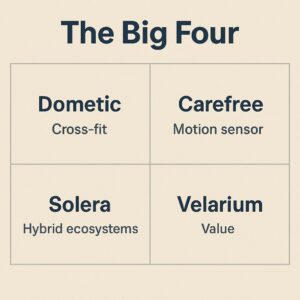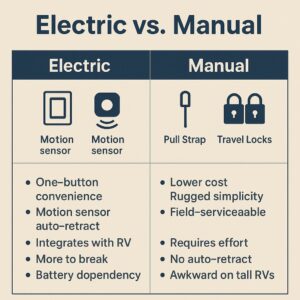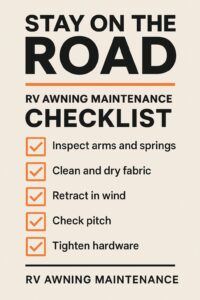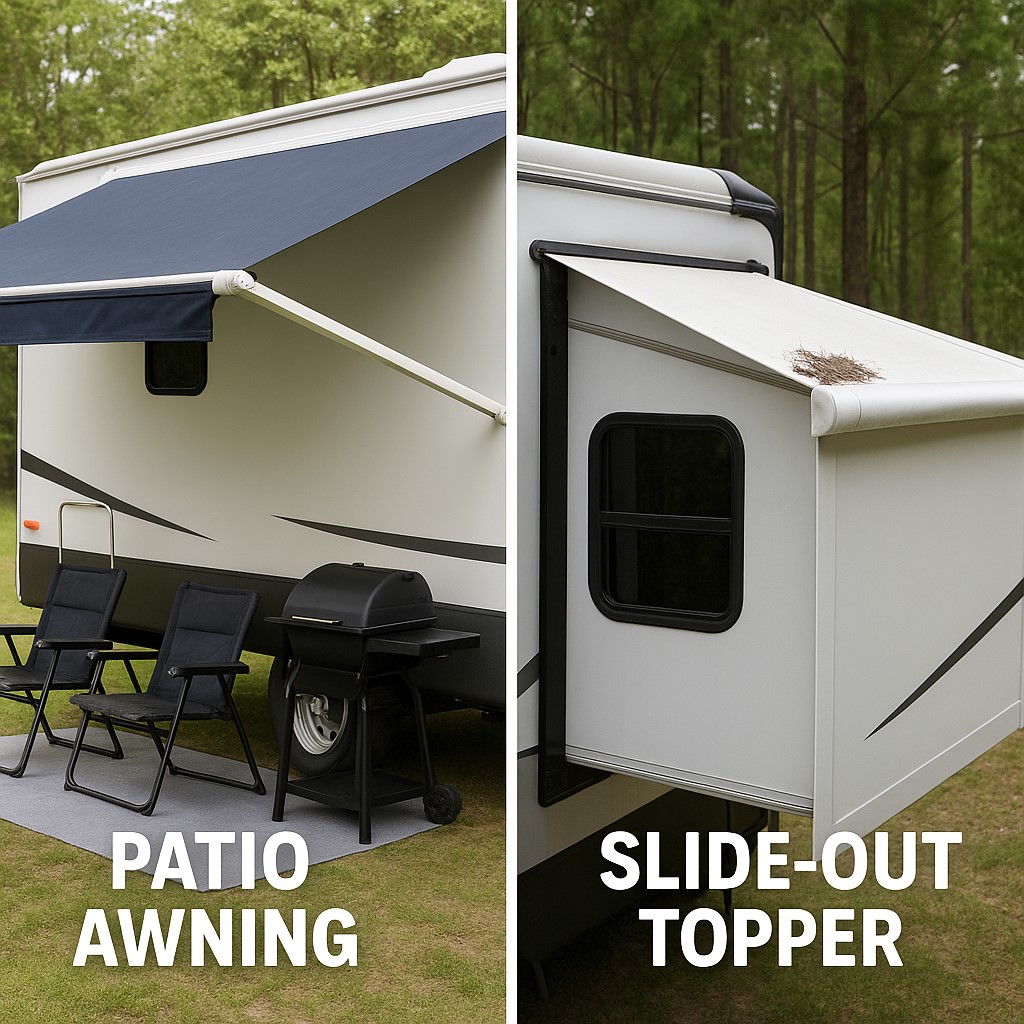RV Awnings Made Simple
RV awnings do more than look good. The right setup expands living space, protects the coach, and keeps you moving—rain or shine—without costly surprises. Below is a straight-talk guide to why awnings matter, which brands lead the U.S. market, what to avoid, and how to choose between electric vs. manual mechanisms (plus notes on slide-out toppers).
1) Why do RVs need awnings?
Patio awnings create shade, lower interior temps, and add a dry “mud-room” at the door. You’ll cook, work, and relax outside more when the sun and drizzle aren’t punishing you.
Slide-out toppers (aka slide awnings) act like shields: they help keep debris, standing water, and UV off the slide roof so seals last longer and you don’t drag leaves or grit into the rig when retracting.
(That prevention is the whole point—less gunk, less water, fewer leaks, fewer seal replacements.
2) When replacing, should you stay with the same brand?
Not required. Many replacement systems are designed to be cross-compatible with existing brackets or arms, especially on patio awnings and slide toppers.
Solera (Lippert) explicitly markets broad aftermarket compatibility with “other major RV brands,” which is why lots of owners swap without re-engineering the sidewall. That said, staying in the same ecosystem can simplify parts, firmware (for motion sensors) and service.
f your coach already has working brackets/arms, matching brand can be faster; if those parts are damaged or you want different features, switching brands is on the table.
3) The four major U.S. brands
 Dometic – Longtime OEM/aftermarket leader with powered patio RV awnings (e.g., 9100 series) and slide toppers; broad parts availability. (Dometic)
Dometic – Longtime OEM/aftermarket leader with powered patio RV awnings (e.g., 9100 series) and slide toppers; broad parts availability. (Dometic)- Carefree of Colorado – Since 1971; full line of electric & manual products, with options like Direct Response motion-sensing auto-retract. (Carefree of Colorado)
- Solera (Lippert) – Major OEM supplier; large aftermarket footprint and universal-fit ethos for replacements and upgrades. (Lippert)
- Velarium (an Airxcel brand) – Newer entrant (joined Airxcel’s family in 2022); focuses on vertical-arm power RV awnings, expanding into slide-out awnings and accessories (e.g., Velocity switch; cut-to-fit tubes for serviceability). (Velarium)
Why these four? They’re widely used by RV OEMs, have national distribution, and publish ongoing product development—key markers of supportability and parts pipeline.
4) Why avoid low-cost “no-name” brands?
Bargain RV awnings often look similar on paper, but the corners cut tend to show up fast: thin fabrics (more stretch, faster UV failure), weaker motors/gearboxes, low-grade hardware/coatings (corrosion), sparse parts and no hotline when you need help.
Major brands publish clearer specs, offer accessories (wind sensors, LEDs, hardware kits), and maintain live parts catalogs. That translates to shorter downtime when something bends, tears, or fails. (If you camp where wind gusts are normal, this difference is real money.)
5) Electric vs. Manual: pros, cons & brand notes
Electric (12V or 120V)
 Pros
Pros
- One-button convenience; easier for solo travelers or tall rigs.
- Add-ons like motion/wind sensors that auto-retract in gusts (e.g., Carefree’s Direct Response). (Carefree of Colorado)
- Integrates with wall switches and sometimes keyfobs/apps.
Cons
- More to break (motor, control board, wiring).
- Battery dependency; you still need to retract before storms if sensors aren’t installed.
- Heavier and costlier than basic manuals.
Good fits: Frequent use, mobility concerns, larger coaches, or places with gusty weather (paired with motion sensor).
Manual (spring-assisted)
Pros
- Lower cost and often more rugged due to simplicity.
- Field-serviceable with basic tools; not dependent on coach power.
Cons
- Requires technique/effort; tall rigs can be awkward.
- No built-in auto-retract.
Good fits: Budget builds, off-grid boondocking, owners who prioritize repairability and don’t mind a bit of elbow grease.
Brand-by-brand flavor
- Dometic: Broad patio/slide range; electric 9100-series power awnings are common on OEM builds; typical vinyl or acrylic fabric options.
- Carefree of Colorado: Deep catalog of manual (Fiesta) and electric (Travel’r, Compass, EclipseXL) with optional auto-retract electronics.
- Solera (Lippert): Strong in replacements/upgrades with universal compatibility messaging and complete kits; wide accessory line.
- Velarium (Airxcel): Newer but growing; service-friendly ideas (e.g., cut-to-fit awning tube) and retrofit electronics (Velocity switch). Backed by Airxcel’s RV ecosystem.
Slide-Out Toppers (a quick buyer’s guide)
- Purpose: Keep water, needles, leaves and grit off the slide roof, reduce pooling and UV exposure, and speed up pack-up.
- Fabric: Look for heavier vinyl with a weather shield or acrylic upgrade in high-UV states.
- Arms/Springs: Robust torsion springs and sealed end-caps last longer.
- Fitment: Measure flange-to-flange and projection; most brands publish good charts.
- Wind/Water: Toppers can billow in crosswinds; park with wind awareness.
How to choose—fast
- Pick mechanism: If you deploy daily or have mobility limits, go electric + motion sensor. If budget/repairability wins, go manual.
- Decide fabric: Vinyl (cost-effective) vs acrylic (breathes better, dries faster).
- Confirm support: Can you get arms, motors, end-caps, tubes, fabric locally or fast-ship? The big four typically can.
- Match ecosystem: If you already run Airxcel/Dometic HVAC or Lippert hardware, staying in-family can simplify parts and service.
- Measure twice: Patio: awning rail to rail; Slide topper: flange width + projection. (Each brand’s chart differs—follow it.)
Maintenance that keeps you on the road
 Retract in high winds unless you have auto-retract—and even then, don’t rely on electronics alone.
Retract in high winds unless you have auto-retract—and even then, don’t rely on electronics alone. - Clean & dry fabric periodically; let it dry before stowing to avoid mildew.
- Inspect arms, torsion springs, set screws each season; tighten loose hardware and replace cracked end-caps.
- Lube sparingly (manufacturer-approved products) at pivot points and lock mechanisms; keep electrical connections corrosion-free.
- Check pitch after install so water sheds properly.
Quick wrap for The Smart RVer
For the few square feet they occupy on your wall, RV awnings do a lot: expand living space, protect slides, and make campsites comfortable. Choose mechanism first (electric vs. manual), then fabric, then ecosystem/parts support. With Dometic, Carefree, Solera, and Velarium, you’ll find proven options for both patio shade and slide protection—and the parts to keep them working season after season. (Dometic)
Do slide-out toppers really help?
Yes. They keep debris and standing water off the slide roof, help protect seals, and speed pack-up—especially after rain or under pines.
Are electric awnings worth it?
If you deploy frequently, have mobility concerns, or camp in gusty areas, electric plus motion sensor auto-retract is a quality-of-life upgrade. Budget/repair-focused owners often choose manual.
Can I mix brands when replacing?
Often yes. Many replacement kits are compatible with other brands’ hardware. Verify bracket patterns and projection in the brand’s fit-chart (Solera is a leading cross-fit option).
Vinyl or acrylic fabric?
Vinyl is cost-effective and durable; acrylic breathes and dries faster—great for humid or coastal climates.
Who are the top U.S. brands right now?
Dometic, Carefree of Colorado, Solera (Lippert), and Velarium (Airxcel). They have national distribution, active development, and parts pipelines
Any “gotchas” when installing?
Measure carefully, mind spring tension (it’s dangerous), use correct fasteners/sealant, and follow the brand’s torque and pitch specs. If unsure, have a pro handle spring-loaded work.
